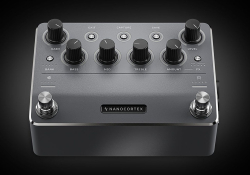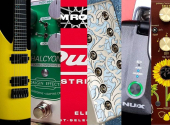
Compact Neural DSP Nano Cortex Processor
In 2020, Neural Capture technology has revolutionised the music world with its superior ability to capture the sonic essence of any amp, stompbox or overdrive, so it's no surprise that the Quad Cortex processor has become the choice of many guitarists and bassists of all genres, despite its relatively high price tag. But Finland's Neural DSP answered the prayers of less affluent players and is launching a scaled-down version of the QC called the Nano Cortex, which uses the basic NC architecture of its older sibling and costs about a third of its price.
The new product, measuring 144 x 103 x 62 mm and weighing 620 g, fits into most instrument gig bags and follows in the footsteps of competitors such as IKM ToneX Pedal, Kemper Profiler Player, Fractal FM3 Mk II Turbo, etc. However, due to the size, we do not expect to find all the editing possibilities and style of the larger Quad equipped with a touchscreen in the Nano version, but the circuits important for the resulting quality of the "fingerprint" are identical.
In addition to 64 presets, 256 Neural Capture slots, 10 pre-installed IR pulse boxes with 5 different microphones plus 6 positions and 256 slots for custom IR samples, the Nano Cortex offers a total of 7 blocks consisting of a Neural Capture unit, an extended IR loader, two Pre-FX units with an adaptive noise gate and Transpose function, a pitch shifter that changes the tuning, and three Post-FX blocks consisting of a chorus emulating the Boss Dimension DC-2W, an analogue BBD delay and a reverb with the sound of the legendary rack-mounted Lexicon 224.
In five banks, graded from the guitar's perspective according to the level of distortion (Clean, Edge, Crunch, High-Gain, Bass), 25 instrument impulses are prepared, represented mostly by widely known preamps including bass amps, and the ten mentioned IR impulses are made up of Fender, Vox, Matchless, Marshall, Mesa, Zilla and Ampeg cabinets.
The control is designed with an emphasis on directness, which is conditioned by the absence of a display – the six potentiometers have diode rings informing about the parameter position in a particular preset, and the two customisable steel footswitches function in the same way as in the Quad, i.e. as potentiometers or encoders at the same time. There are also five buttons on the main panel with the classic Bank, Exit, Capture, Save and FX functions.
The Nano Cortex boasts that no additional software or computer is needed when creating a custom sample, the integrated sound card (24-bit/48kHz) can be used for direct recording, and, of course, there is also a tuner, corresponding editing application and Bluetooth catering for wireless download of sounds, settings, libraries etc.
Connectivity consists of an input, a pair of outputs, an Exp/MIDI jack, a headphone mini-jack with its own volume, a USB-C port that can also be used for power, and on the right side of the brawny chassis there's a Boost switch (+26dB) and a Capture XLR/TS input jack. The conventional power supply is handled by a 9/12V 600 mA DC adapter.
For many musicians, the compact version of the Neural DSP Nano Cortex can be the ideal help and master station for mastering studio and concert work, across genres, aided by free access to the company's Cortex Cloud with thousands of different samples. The official European price is around 570 euros.
If you have found an error or typo in the article, please let us know by e-mail info@insounder.org.






